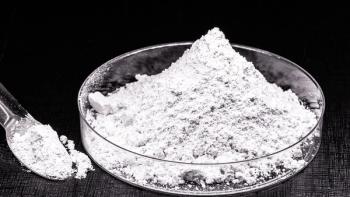
Pharmaceutical Technology Europe
- Pharmaceutical Technology Europe-08-01-2010
- Volume 22
- Issue 8
New Technologies For Pharmaceutical Manufacturing: Addressing Cost, Containment And cGMP Requirements
New isolator and disposable technologies are set to assume a greater role in pharma manufacturing, according to a recent conference in Germany.
New isolator and disposable technologies address cost, containment and cGMP requirements and, as the technologies are further refined, they will play a greater role in the future of pharmaceutical manufacturing.
GETTY IMAGES/IMAGEWERKS
Recent trends facing the pharmaceutical industry pose numerous challenges to manufacturers. Large and small companies focused on both small molecule and biological therapies must conduct operations in accordance with cGMPs and protect their employees and the environment from exposure to the increasing number of highly potent actives being developed today. At the same time, cost control has now more than ever before become a primary issue for all players in the industry.
Equipment manufacturers have responded to the changing conditions with the introduction of technologies that require lower capital investment, provide improved efficiencies and the enhanced containment levels necessary for potent substances. Isolated systems and the availability of a wide range of disposables with applicability from lab to commercial scale, and throughout the entire production process from reaction to final filling and packaging, are helping to dramatically improve operating efficiencies (and thus reducing costs) while increasing employee protection.
A recent conference organised by the International Society for Pharmaceutical Engineering (ISPE) at Bosch Packaging Technology in Waiblingen (Germany) focused on these issues. Speakers from both pharmaceutical and CMOs exchanged information on technical approaches to containment design. They also discussed key trends in high containment, including protection of employees, avoiding crosscontamination, cleaning processes and new equipment options for filling operations.
The containment conundrum
The need for a better understanding of high containment is driven by the rapid growth of the pharmaceutical market. Just 10 to 15 years ago, only a small fraction of drugs were classified as highly potent compounds. Today, that percentage has been multiplied many times over and will continue to grow as highly potent compounds are developed to treat chronic heart disease, musculoskeletal problems, central nervous system disorders and other health problems, as well as cancer. With highly potent drugs, much less active ingredient is required in the final formulation, which leads to cost savings for manufacturers. A rising interest in personalised medicine is also leading to the development of targeted therapies, which often require highly potent actives.
Working with potent compounds presents a different set of manufacturing challenges, though. Although these drugs can be highly effective at fighting disease, they can pose a real threat to healthy people and thus present a heightened exposure risk, leading to the need for higher containment levels, which in turn require higher investment costs compared with non-potent drugs. Smaller market sizes for these specialised products means that most manufacturers need to produce multiple products in a given facility. GMP requirements for cleaning validation of systems can be time consuming and add significant cost too.
Isolating the problem
Approaches to containment of highly potent drugs are evolving — as attendees at the ISPE conference learned. At the conference, attendees recognised that over the past several years there has been an increase in attention paid to operator and environmental safety at the development and production stages within the pharma industry, with an emphasis on equipment engineering as the primary solution.
Early containment programmes focused on personal protection for the operators, according to Dr Bernd Mümmler, Director of Pharmaceutical Production for contract manufacturer Excella. "Now we have a three-step approach, and personal protective equipment is the third line of defence, serving as a back-up only to equipment design and use of specifically adapted procedures."
Such carefully designed equipment not only better protects employees, but also ensures against crosscontamination and increases flexibility and efficiency, while reducing the cost of manufacturing operations.
Isolator technology is one example of this new approach to containment that has attracted significant interest. "The most impressive step I have noted in containment technology is the change to small equipment isolators and the move away from reliance on cleanrooms," observed Dr Wolfgang Kramp, Senior Manager of Quality Assurance at Fischer Clinical Services GmbH.
An ideal application for such smaller containment areas is the solid capsule filling process, where generation of particulates is unavoidable. Isolators make it possible to minimise the containment area and increase the protection of workers.
Recent advances in isolator technology include the incorporation of automation and integration, according to Dr Torsten SchmidtBader, Managing Director at moveproTEC. Automated washinplace (WIP) and cleaninplace (CIP) systems ensure a consistent cleaning process, and further reduce any interaction between the operator and the highly potent drug. It also takes less time for validation since a pre-established sequence of steps is employed.
The introduction of automated inspection and control systems throughout the process — Process Analytical Technology (PAT) — further ensures consistency, high quality and enhanced safety. With the use of such "closed loop control," the process can only proceed from one step to the next if no problems are identified or until any issue that arises is resolved.
When integration is incorporated with automation, even more benefits of isolator technology can be observed. "With integration," noted Schmidt-Bader, "automated elements work seamlessly together to provide a very efficient and effective filling system."
Disposable solutions
Disposable components have increasingly become another attractive option for addressing containment issues, particularly for the production of developmental quantities of material. With singleuse technology, manufacturers have much greater ability to produce multiple drugs — a capability that can be a true differentiator in a highly competitive marketplace.
Figure 1Disposables come pre-sterilised by the supplier using a consistent and validated process, eliminating the need to dedicate product-contact parts, a particular issue with highly potent substances. Time-consuming cleaning operations that are hard on the equipment and specialised waste treatment processes are also avoided. The potential for crosscontamination is minimised and the time required for changeover from one product filling operation to another is reduced from days or weeks to hours.
In addition to eliminating the costs associated with CIP and sterilisation in place (SIP) processes, single-use technology also requires lower capital investment. Properly designed disposable systems can also be scaled to fit the production quantities needed as the product development process advances.
Risks associated with the filling operation can also be reduced with single-use components. The possibility for product reactivity with stainless steel equipment (the material of choice for most filling systems) is removed. Leakages that might occur with hard connections can be avoided with disposables, which can be readily replaced at any time during the process.
"We expect to see an increasing number of parts made as disposable components," remarked Mümmler. "WIP will remain a key element of containment systems, but only for parts that cannot be adapted to a disposable design." Growth of singleuse components is expected by some attendees to be most notable for production of developmental quantities, and particularly for the manufacture of product to be used in clinical trials. "Because we don't yet know the full properties of the new active ingredient, we cannot be sure that even properly completed CIP procedures will be adequate. So disposables are the preferred technology, followed by WIP and then CIP."
Technology for the future
Both isolator and disposable technologies provide many advantages for pharmaceutical companies manufacturing highly potent drugs, but issues remain to be resolved with both approaches to containment. However, equipment manufacturers are continuously working closely with pharmaceutical industry customers to develop cGMP-compliant solutions that enhance the equipment performance, incorporating features that will further improve the flexibility, scalability and ease-of-use of these valuable techniques throughout the development cycle and for commercial production.
Melanie Beck is Product Manager, Capsule Filling at Bosch Packaging Technology.
Articles in this issue
over 15 years ago
Biosimilars: Is It Worth Taking On The Regulators?over 15 years ago
Pharma Takes Control Of Distribution Chainsover 15 years ago
Is Your Packaging Line Operating To Full Capacity?over 15 years ago
The New EMA Bioequivalence Guideline: Key Considerationsover 15 years ago
The European Generic Medicines Associationover 15 years ago
Newsover 15 years ago
Can Payers Afford To Watch And Wait?over 15 years ago
Latest EU Guidelines For Biosimilars Dissectedover 15 years ago
The Changing Landscape For BiosimilarsNewsletter
Get the essential updates shaping the future of pharma manufacturing and compliance—subscribe today to Pharmaceutical Technology and never miss a breakthrough.




